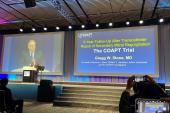Medical Therapy ‘Disappointing’ Prior to TEER for Functional MR: TVT Registry
Just one in five patients were taking three key HF drugs before getting a MitraClip, a retrospective analysis has found.

Patients with mitral regurgitation (MR) secondary to heart failure (HF) are often poorly treated with guideline-directed medical therapy (GDMT) before undergoing transcatheter edge-to-edge repair (TEER) with MitraClip, according to a new analysis.
“MitraClip is an expensive therapy, an invasive procedure, and so the fact that a lot of the patients aren't being treated with a noninvasive option that's known to be safe and highly beneficial was a little bit disappointing,” lead investigator Anubodh S. Varshney, MD (Stanford University, Palo, Alto, CA), told TCTMD.
One of the striking findings, he added, was that the reason for the low use of GDMT does not appear to be entirely due to patients being unable to tolerate therapy due to hemodynamic, electrolyte, or kidney function limitations or side effects. In an analysis of centers that performed at least ten TEERs per year, there was a wide range of patients prescribed triple therapy (0% to 61%), with 10 sites implanting MitraClip in zero patients who were receiving all three HF drug classes prior to the procedure.
“There was a really striking and broad variation across centers in the type of medical therapy or the amount of medical therapy these patients were on before undergoing a MitraClip,” said Varshney, noting that they adjusted for center- and patient-level characteristics.
MitraClip is an expensive therapy, an invasive procedure, and so the fact that a lot of the patients aren't being treated with a noninvasive option that's known to be safe and highly beneficial was a little bit disappointing. Anubodh S. Varshney
Colin Barker, MD (Vanderbilt University Medical Center, Nashville, TN), who wasn’t involved in the study, said the real-world use of GDMT in the TVT Registry is in line with what’s been observed in prior studies. GDMT requires frequent follow-up, titration, and management, so there are often large gaps between care received in clinical trials versus patients treated in practice.
The reasons for underutilization, he added, are likely multifactorial.
“Heart failure patients don't feel well so if there are multiple medications that they would need to take to feel better, they’ll do it as long as they're not prohibitively expensive,” he told TCTMD. “There’s definitely a side-effect profile that has to be balanced, with a lot of these medicines causing fatigue and other things that can sometimes be hard to tease out.”
He noted that patients prescribed no medication, or just a single agent, were sicker than those treated with two or three drugs. “In those cases, they generally don't tolerate a lot of GDMT because they're walking around with low blood pressure, borderline kidney function, and may have other challenges,” said Barker.
The new study was published in the European Heart Journal.
Background GDMT in RCTs
COAPT and MITRA-FR both tested MitraClip (Abbott) in patients with HF and severe functional MR and showed notably different results. COAPT found that TEER reduced the risk of HF hospitalizations, the study’s primary endpoint, as well as mortality at 2 years, while MITRA-FR researchers found no difference in the rate of the deaths/HF hospitalizations among patients treated with either the MitraClip or best medical care.
This discrepancy led to significant debate among researchers and specialists attempting to explain the conflicting results, with some suggesting it could be due to differences in baseline characteristics or background medication use. In COAPT, the study protocol trial included a review of all HF medications prior to enrollment, with titration to maximally tolerated doses, whereas MITRA-FR didn’t include such a protocol.
In the United States, on the basis of COAPT, TEER received an expanded Food and Drug Administration indication and is now has a class 2a (level of evidence B) recommendation for patients with severe secondary MR and persistent symptoms despite being treated with optimal GDMT.
In the new analysis, investigators wanted to assess real-world use of GDMT among centers included in the TVT Registry. The study included 4,199 patients (mean age 73 years; 38.2% female) from 449 hospitals with preprocedure LVEF less than 50% who underwent TEER for functional MR.
Patients who were prescribed no medical therapy or just a single drug were more likely to have NYHA class 4 symptoms, higher serum creatinine levels, lower hemoglobin levels, and were more likely to have at least moderate tricuspid regurgitation (TR) when compared with the other groups.
The 30-day adjusted risk of all-cause mortality or hospitalization for HF was significantly lower in those given double therapy prior to TEER (HR 0.53; 95% CI 0.38-0.74) and trended lower in those assigned triple therapy (HR 0.70; 95% CI 0.47-1.03) when compared with those taking no GDMT or single therapy.
For patients with data at 1 year, the composite rate of all-cause mortality or HF hospitalization after TEER was 23.1% in those taking triple therapy, 24.8% in those taking double therapy, 35.7% in those taking a single drug, and 41.1% in those not taking any GDMT prior to the procedure. After adjustment, the composite endpoint was significantly lower in patients prescribed triple therapy (HR 0.73; 95% CI 0.55-0.97) and double therapy (HR 0.69; 95% CI 0.56-0.86) compared with those taking a single or no HF drug.
The 1-year mortality rate for those on zero drugs or a single drug was 24.4% compared with 13.7% and 13.9% in those treated with double and triple therapy. Varshney said if patients on zero/single therapy are truly intolerant to GDMT intensification, the high mortality rate suggests they should be considered for durable mechanical circulatory support and/or heart transplantation instead of TEER because outcomes are considerably better in appropriate candidates for advanced therapies.
To TCTMD, Barker said these new data show that GDMT and TEER are complementary, noting that when used in combination the effects are synergistic for outcomes at 30 and 365 days. “So that was encouraging to see because that's the ideal patient, the one who is not too sick where they can tolerate GDMT, but still have severe functional MR,” he said.
No SGLT2 Inhibitors
Notably, the new analysis does not document the number of patients taking sodium glucose cotransporter 2 (SGLT2) inhibitors, the newest drug class that forms the four pillars of HF therapy, even though the current US guidelines recommend SGLT2 inhibitors in a broad spectrum of HF patients. At this point, the TVT Registry does not yet capture these prescriptions.
Varshney said it appears that SGLT2 inhibitors are being adopted relatively quickly compared with other HF therapies because they have broad indications and are considered safe medications. “Hopefully, they are going to be used a little faster than some of these older therapies, but I think in future work we'll probably find that they're still underutilized in this population,” he said.
In terms of why GDMT is so infrequently used, Varshney suspects it’s the result of the fragmented US healthcare system, especially in the advanced HF world, a situation that challenges the easy titration of medical therapy.
“A patient may only see their advanced heart failure cardiologist one or two times a year,” he said. “The general cardiologist might be doing a lot of day-to-day medicine management and the primary care physician might be doing even more than that. There's not a clean system that minimizes the inertia to titrate and then monitor side effects or labs.”
Justin Ezekowitz, MBBCh, MSc (University of Alberta, Edmonton, Canada), a HF specialist who commented on the study for TCTMD, said a better focus on GDMT prior to TEER “should be mandatory for any center considering this as a program,” noting that an optimization time of 3 to 6 months with GDMT is necessary to ensure the procedure is needed. The new analysis has limitations, though, he said, pointing out that it lacks the granularity to truly assess the clinical scenario of why patients were treated as they were.
Barker said their center prioritizes GDMT when a patient with functional MR is referred for TEER.
“We frequently will get de novo functional MR referrals for MitraClip where they haven't been put on any medication, which is fair as this could be from a primary care physician or somebody else,” he said. “We will then talk to the patient and have them seen by the heart failure team, which will subsequently get them optimized over time. It could be 6 to 12 months and then we’ll reevaluate their symptoms and any residual degree of functional MR.”
In terms of ensuring that patients are well treated with GDMT prior to TEER, Varshney said the introduction of a formal heart team, just like in the TAVI world, could do a lot of good.
“With TAVR, you have to document the heart team involvement, meaning that a surgeon and interventionalist have seen the patient, to bill for the procedure,” he said. “If you tie the procedure to a formal heart team evaluation, we might see a bigger uptick in the use of medical therapy prior to the procedure. We might also see that that some patients have their medical therapy optimized and don't need the procedure at all because their mitral regurgitation gets better.”
Michael O’Riordan is the Managing Editor for TCTMD. He completed his undergraduate degrees at Queen’s University in Kingston, ON, and…
Read Full BioSources
Varshney AS, Shah M, Vemulapalli S, et al. Heart failure medical therapy to mitral transcatheter edge-to-edge repair: the STS/ACC Transcatheter Valve Therapy Registry. Eur Heart J. 2023;Epub ahead of print.
Disclosures
- Barker reports research grants from Edwards Lifesciences, Abbott, and Medtronic.





Comments